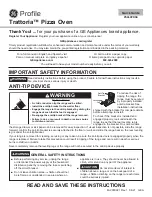
10
49-2000921 Rev. 1
Lower Oven Cooking Modes and Recommendations
Follow these general recommendations for better results. The modes listed below are not available in all ovens.
For a complete list of modes and a cooking guide with recommended rack positions, see the full owner’s
manual at cafeappliances.com/literature.
NOTE:
Remove unused racks when using the oven for faster preheat, improved efficiency and optimal performance.
Bake
:
Use this mode for general baking on a single rack.
Place food in approximately the center of the oven.
Convection Bake
:
Use this mode for baking
on multiple racks. Your oven is equipped with Auto
Recipe Conversion, so it is not necessary to adjust the
temperature when using this mode.
Convection Roast
:
Use this mode for roasting
meats or vegetables. Auto Recipe Conversion is not
applied in this mode.
Broil
:
Use this mode for searing foods. Always broil with
the door closed. For better searing or browning, place food
closer to the broil heater.
Oven Probe
:
Use the probe to bake foods to a precise
temperature. For details on proper use see the full owner's
manual.
Additional Modes
:
Your oven may have additional
specialized cooking modes. Press
Options
to explore and
see full owner’s manual for details.
Lower Oven Special Features
For other special features such as Sabbath mode, please see full owner's manual at cafeappliances.com/literature.
There are several different special features on your range.
Adjust the Oven Temperature
This feature allows the oven baking temperature to be
adjusted up to 35ºF hotter or down to 35ºF cooler. Use
this feature if you believe your oven temperature is too hot
or too cold and wish to change it. This adjustment affects
every cooking mode except broil. Press
Setting
pad and
select
Oven Adjustment
. Use the number pad to select
more or less heat. Once the adjustment is set, press
Save
.
CAUTION
Do not use any type of foil or oven liner to cover the oven bottom and upper oven cooking
surface. These items can trap heat or melt, resulting in damage to the product and risk of shock, smoke or fire.
Damage from improper use of these items is not covered by the product warranty.
Foil may be used to catch spills by placing a sheet on a lower rack, several inches below the food. Do not use more foil
than necessary and never entirely cover an oven rack with aluminum foil. Keep foil at least 1-1/2” from oven walls to
prevent poor heat circulation.
Aluminum Foil and Oven Liners
Upper Oven Pizza and Bread Cooking Surface
Wait for cooking surface to cool before cleaning and clean
cooking surface before each use. Only clean cooking
surface with warm water and mild dish detergent. Do not
use harsh cleaners, abrasives, steel wool or a brush with
steel bristles because this will scratch the cooking surface.
Use a wet sponge with warm soapy water to wipe up any
hardened dough and pizza toppings. Do not use a metal
scraper or abrasive cleaner because it will scratch the
cooking surface. We recommend the use of a plastic scraper
to remove baked-on soils from the cooking surface.
Wooden Pizza Peel
Scrape your wooden pizza peel for hardened dough and
pizza toppings using a plastic scraper. Never use a metal
scraper because this will damage the wooden surface. Use a
wet sponge with warm soapy water to sanitize your wooden
peel. Do not put the wooden pizza Peel in water to prevent
cracking or warping. You can air-dry your wooden pizza peel
on a dish rack. Never put the peel in the dishwasher. Do not
use olive oil or any vegetable oil on your wooden pizza peel.
It will cause the wood to smell and will not prevent the dough
from sticking to the surface of the peel. Do not use your
wooden pizza peel as a chopping or cutting board. Your,
knife, pizza wheel, or any sharp equipment that you use to
cut a pizza with will leave a scar on the surface. This will
result in the sticking of raw dough to your wooden pizza peel
preventing your pizza from not sliding into the oven.
Cleaning the Pizza Oven












